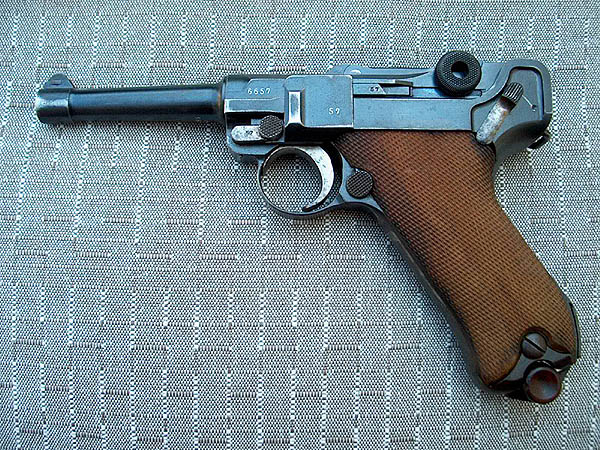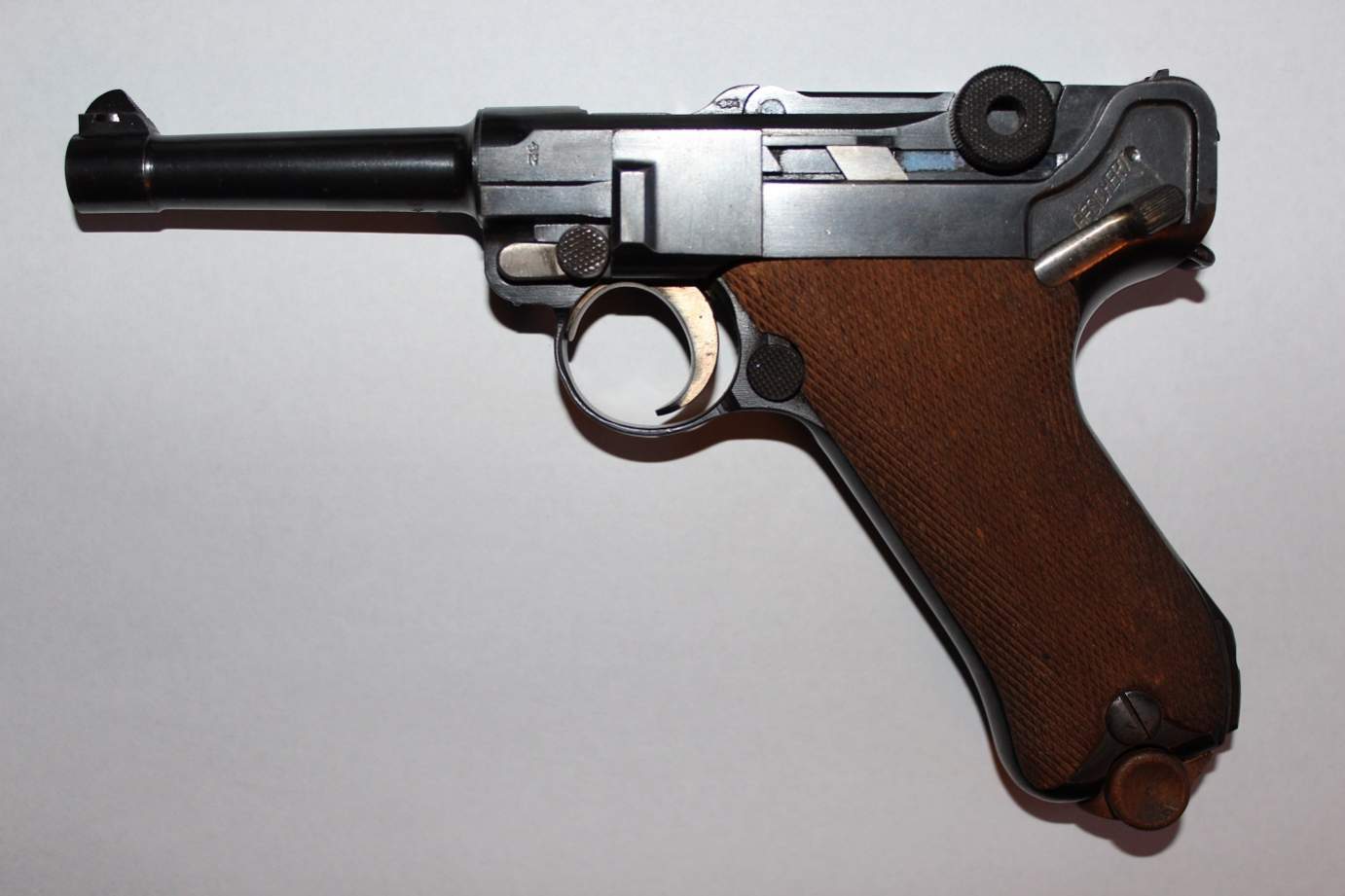Luger Serial Number Identification
I joined lugerforum.com this morning, posted my question and some pic's and got my answer. I had my hopes up that it was a fairly rare 1914 or 1920 Commercial Navy model.
I have a matching numbers P.08 Luger that my dad brought home from the war. On the top of the receiver it has 42 and byf on the top of the frog leg. I think it was made by Mauser, but I would like to know more about it, The serial number is 3830. Can anyone tell me what the probable date of manufacture is. The 45 Luger is merely an enlarged version of the 9mm Model 1902/06 with slight modifications necessitated by the use of the larger cartridge. The only specimen known to exist today bears the serial number “2” and is truly a fine example of Luger workmanship. The initials “GL” appear on the rear toggle.

However, the sights gave it away. It is a 1920 Commercial model made in 1924. They're telling me that the barrel was swapped out at some point, but the serial number markings are still a mystery. Could Luger have swapped the barrel? It's not impossible. As it is, it's probably worth about 1/2 value, which is what I paid for it. Nice to know I didn't get ripped off and I had several comments about how good of shape it's in.

It really is a great shooter, with real sights, target pistol quality. The trigger is unlike any other gun I've shot.
It barely moves and the pull is probably around 4#. Nice and crisp. Well, at least the mystery is over. There some nice folks over there on lugerforum.com and the site is setup the same as this one.
Pistole Parabellum Kyrie 1923 Commercial Luger The 1923 Commercial Luger variation are those Lugers in the commercial serial number range of approximately 73,500 to 96,000 (about 18,000 pistols). These were pistols made in the 1920's for commercial sale in Germany and elsewhere. Serial number placement is in the commercial ('hidden') style. Safeties will generally be marked 'Gesichert' and extractors 'Geladen.' Barrels may vary in length from 3 5/8' to 24' or longer, and are usually chambered for the 7.65 Parabellum (.30 Luger), but may be chambered for the 9 mm Parabellum (9 mm Luger).
Proof marks are Crown over 'N' (C/N), and may be found on the underside of the barrel, the left of the barrel extension, the left of the breechblock, and the left of the first toggle link. The first toggle link is generally marked with the DWM monogram, and there is the 'V' rear sight on the last toggle link. Frames will have the stock lug, and a grip safety may be present. Longer barrels (longer than four inches) are thought to have been installed by local dealers rather than by DMW. These barrels may or may not be numbered or proofed. There is considerable variation in the 1923 Commercials.
Proof marks may or may not be where they are expected, and all proof marks may or may not be present. Left side of a 1923 Commercial Luger. This specific example is chambered for the 7.65 Parabellum, and has a six-inch barrel. Note the C/N proof on the left of the barrel extension.
Also pictured is the end flap from a current production box of Winchester.30 Luger ammunition. There are also three rounds of ammunition in the picture. From top to bottom, these are: 1) a round of Winchester.30 Luger set so the cartridge headstamp can be seen, 2) a round of Winchester.30 Luger set on its side so it can be seen as a 7.65x21 bottlenecked cartridge, and 3) a round of 7.63x25 Mauser (.30 Mauser) ammunition. I have included the round of 7.63x25 Mauser because people unfamiliar with either Lugers or Mauser C96 'Broomhandles' sometimes confuse the.30 Luger and the.30 Mauser cartridges. Shooters new to.30 Luger chambered pistols have been known to see bargain basement prices on military surplus 7.62x25 and, thinking.30 Mauser is just another name for.30 Luger, buy this ammunition by the case lot to fire in their Lugers. They are disappointed to find a.30 Mauser cartridge will not chamber in a.30 Luger pistol. Shooters new to.30 Mauser C96's sometimes make the same mistake in reverse, and buy.30 Luger for use in their C96's.
Alas, the.30 Luger cartridge will feed and fire in a.30 Mauser C96 - frequently to the detriment of the C96. Right side of the same 1923 Commercial Luger. Note the absence of any Imperial Army acceptance or proof marks on the barrel extension. Driver And Vehicle Services Rochester Mn. While the 1923 Commercial variation is usually regarded as being of completely new, post-war manufacture, it is not rare to find scrubbed Great War Luger parts used to assemble 1923 Commercials. This pistol in particular is an example of this. The receiver ring of this pistol's barrel extension shows noticeable thinning on top, indicating something (probably a date) was removed. This removal was done carefully, and the receiver ring shows a graceful curve - unlike the same part in the 1923 Finnish contract Luger also pictured here in the Owners' Corner.
Close-up photograph of the C/N barrel extension proof. Close-up photograph of the 'lazy' C/N proof on the first toggle link. The breechblock is not proofed. Close-up of the DWM monogram on the first toggle link. Close-up photograph of the frame serial number.
The photo was taken with the takedown lever extended into the disassembly position so the serial number on the bottom of the takedown lever is visible. In the commercial serial number placement, the serial numbers on small parts were placed on the side rather than the top of parts, to avoid visually cluttering the graceful lines of the pistol with markings. The six-inch barrel on this specific 1923 Commercial is not proofed, and is marked only with the number '359.' The origin and significance of this number is unknown. While this number is not related to the pistol's serial number, it is of the same style and placed in the same manner as the barrel number on the 1920 Commercial Artillery also pictured here in the Owner's Corner. The similar number on the 1920 Commercial Artillery does match the pistol's serial number, providing us food for thought and (no doubt some spirited speculation). Here is the US during the 1920's Pacific Arms was known for its importation of Lugers to be sold commercially, and is thought to have furnished and installed many of the longer length barrels found on its Lugers.
It is possible this is a Pacific Arms imported Luger. Note, however, this Luger is not marked 'Germany' as were most of the Lugers made for export from Germany to the US. Close up of the (mismatched) wood magazine bottom on this pistol's magazine. This appears to be the spare magazine (note the '+' sign) to a Great War Imperial Luger, serial number 3161. It is not known whether this magazine was originally delivered with this Luger.
Photos Courtesy of Kyrie Ellis. Easycap002 Driver Download Windows 7.